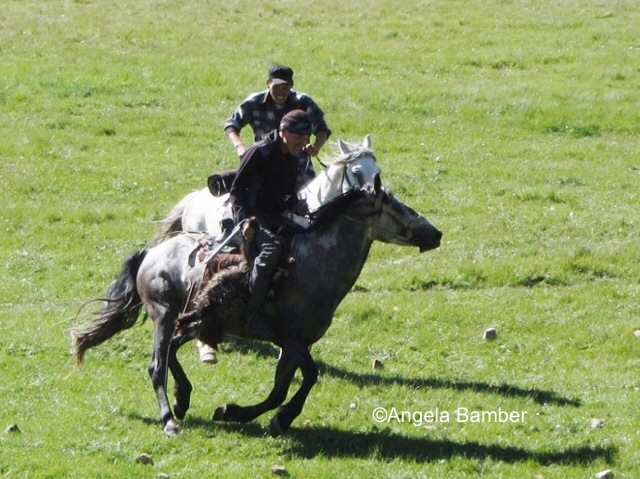Goat Polo 101. Teams: Two on horseback. Ball: one dead goat. Goal: rock, pole, drawn circle or mound. Objective: grab the goat and take it to the opponent’s goal. Winner: the team with the most goals within the designated time. Rules: do not deliberately whip or unseat another rider. Prize: a donation from a sponsor, ranging from money to fine clothes.
Kokpar or Buzkashi is literally translated as 'goat grabbing' and colloquially known as 'goat polo'. It is a game popular in Central Asia where horse-mounted players use a goat carcass to score goals. The goat carcass usually has the head, hooves and intestines removed and is then stitched shut. The carcass is sometimes stuffed with sand to make it heavier.
The history of Buzkashi is a little sketchy. There are reports it is a throwback from the days of Ghengis Khan, when there were horseback raids and counter raids on the livestock of other nomads. Or when nomads raced to reach the village first with the spoils of a hunt.
It is easy to see how the game offers a chance to have some fun and hone the skills of rider and horse in a region where the wild horse was domesticated nearly 6,000 years ago.
Although it was banned by the Taliban, Buzkashi is popular in Afghanistan. It has also enjoyed increasing popularity in Russia, China, Turkey, Mongolia, Kazakhstan, Kyrgyzstan, Uzbekistan, Turkmenistan and Tajikstan. In parts of China, they may ride on yaks. In some places a calf is used and not a goat. In Afghanistan, the teams may number over 50 riders.
Last year, Asia's first goat polo championships were held in Kazakhstan. An official Buzkashi rule book was drawn up. More than 100 participants from nine countries competed over four days for the 10 million tenge prize money. Even more money would have been gambled amongst the spectators.
While travelling with British overlanding company Dragoman we stayed in yurts near Song-Kul Lake in Kyrgyzstan. One afternoon we watched the locals play Buzkashi. In this case there were two teams of two riders competing for both our prize money and the goat (which will be cooked and eaten).
The game commences when the referee drops the goat onto the ground. The first part of the game then consists of one goal – picking up the goat. This is obviously very difficult from the back of a horse, and even more difficult when there are other horses and riders, simultaneously attempting the same thing and preventing you from doing so. However, eventually one rider, with his team mate blocking the opponents, manages to lean over and grab a hold of the goat. The horses and riders press around him.
The absence of a rule book creates a wild, dangerous, chaotic game devoid of grace or apparent strategy. The riders launch themselves at each other fearlessly, whipping their horses, urging them into the fray. It is a full contact sport for both horse and rider – a kind of horseback rugby.
The tight scrum moves sluggishly around the pitch before a rider makes a break and is pursued. Goat’s hair flies as the riders grab at the carcass, but the goat is held securely between one of the rider’s legs and the horse.
The game develops a rhythm. The teams alternately form and break scrums. The pack moves around the pitch.
Our attention begins to wander. It is difficult to see what is happening inside the scrums. It is difficult to separate the horse and riders into two teams. Who has the goat? Is one team getting the upper hand?
Then from one scrum a rider breaks free and casually drops the goat carcass onto the ground. The scoring of a goal is almost an anti-climax.
**** Buzkashi is an unusual game, but it fits into the culture and landscape of Central Asia.So if its Western equivalent, Polo, is the Sport of Kings, then maybe Buzkashi is the Sport of the People.



